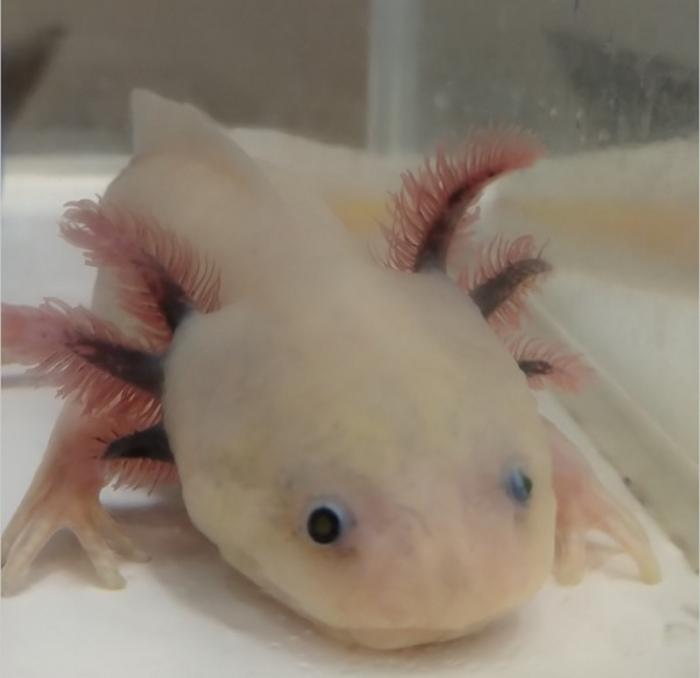In a pivotal study that challenges decades-old assumptions about skin biology, researchers from Okayama University have revealed a surprising new role for keratinocytes in the formation of collagen in the skin, as captured in the unique model of the axolotl. Historically, fibroblasts—a specialized type of cell located within the dermis—were believed to be the sole producers of collagen, the protein responsible for skin strength, elasticity, and texture. However, using advanced methodologies in microscopy, this research has uncovered that keratinocytes, the predominant cells in the outer epidermal layer, also contribute significantly to collagen production, altering our understanding of skin composition and elasticity.
The use of fluorescence-based microscopy was instrumental in this research. By employing this advanced imaging technique, scientists were able to visualize the intricate processes underlying collagen synthesis. In stark contrast to previous beliefs, the fluorescent signals indicated a source of newly synthesized collagen fibers that were produced by keratinocytes rather than the fibroblasts, underscoring the need to rethink the established dogma in dermatological science. Ayaka Ohashi, a Ph.D. student involved in the research, emphasized the study’s implications for both cosmetic science and the broader field of skin biology, noting that the understanding of collagen formation will shift focus toward the role of keratinocytes.
As the researchers continued their investigations, they observed that keratinocytes create collagen in a specific, ordered structure, akin to a lattice. This substrate would later be modified by incoming fibroblasts, which adapt and reinforce the collagen framework as the organism matures. This coordinated process not only provides structural integrity but may also hold the key to understanding how skin regeneration can occur efficiently and effectively in species renowned for their regenerative abilities, such as axolotls.
Interest in these findings extends beyond just academic curiosity; the potential applications are profound. Understanding the mechanisms behind dermal collagen formation could lead to revolutionary advancements in therapeutic treatments targeted at skin aging, wound healing, and other dermal conditions. The current skincare landscape heavily emphasizes fibroblast activity, with treatments designed around manipulating this cell type’s functions. The introduction of keratinocytes as a principal player in collagen synthesis heralds a new direction, which could unlock innovative strategies for maintaining and restoring skin health.
The implications of this research also resonate in the context of human dermatological health. In people, the ability to maintain robust collagen production diminishes with age, accompanied by the prevalent signs of skin aging such as wrinkles, sagging, and loss of elasticity. If scientists can elucidate the mechanisms regulating keratinocyte-driven collagen production in axolotls, there lies a tantalizing prospect of translating this knowledge into therapeutic solutions for humans. Professor Akira Satoh from Okayama University passionately theorizes that this research not only illuminates the aging process in human skin but also paves the way toward the potential attainment of “eternal youth,” similar to the axolotl, by enhancing collagen production in humans.
Examining other vertebrates confirmed the universality of these findings. The researchers expanded their inquiry to include zebrafish, chick embryos, and mammalian models such as mice, discovering that keratinocyte-driven collagen production is not unique to the axolotl; rather, it appears to be an evolutionarily conserved mechanism across various species. This revelation underscores a significant shift in how biologists understand dermal biology in multiple species, enhancing the broader discourse on tissue regeneration and skin health.
Furthermore, understanding the specific biochemical pathways utilized by keratinocytes in collagen synthesis may pave the way for the development of new biomaterials that can mimic skin properties or improve healing processes in clinical settings. For example, novel regenerative therapies could aim to promote keratinocyte activity in damaged skin and enhance wound healing, significantly improving outcomes for patients with skin injuries.
As researchers continue to dissect the complexities underlying collagen formation, there will be a heightened focus on multidisciplinary approaches combining molecular biology, tissue engineering, and clinical dermatology. This amalgamation aims to foster innovations that translate laboratory discoveries into practical applications that can benefit human health and wellness. At its core, the study conducted by Okayama University acts as a catalyst, propelling forward the inquiry into skin biology and offering hope for future advancements in skincare and dermatological therapies.
Moving forward, the necessity for further research remains paramount, particularly in understanding how environmental factors and lifestyle choices may influence keratinocyte and fibroblast interaction and function. Questions about how these cellular dynamics change with age, disease, or external influences warrant deeper investigation to fully grasp their implications on skin health.
Overall, the groundbreaking work from Okayama University reshapes our understanding of dermal biology, revealing a vibrant and active role for keratinocytes in collagen production that was previously overlooked. This watershed moment has the potential to not only redefine dermatological science but also provide invaluable insights into skin health and aging across a plethora of species—including humans. The research elucidates how an organism’s ability to produce collagen may ultimately dictate its longevity and health, sketching the outlines of a new era in skincare science that prioritizes the integration of keratinocytes into both therapeutic strategies and cosmetic developments, greatly enhancing the pursuit of youthful, resilient skin.
The findings from this study hold promising implications for regenerative medicine, therapeutic skincare, and our overall approach to understanding the dynamics of skin biology. They provide a hopeful glimpse into the potential for innovations that could transform skincare and dermatological health for generations to come.
Subject of Research: Collagen synthesis in skin through keratinocytes
Article Title: Keratinocyte-driven dermal collagen formation in the axolotl skin
News Publication Date: 24-Feb-2025
Web References: Nature Communications
References: DOI: 10.1038/s41467-025-57055-7
Image Credits: Professor Akira Satoh from Okayama University, Japan
Keywords: Life sciences, Keratinocytes, Fibroblasts, Regeneration, Skin regeneration, Developmental biology, Animal models, Collagen
Tags: advanced microscopy in biological researchaxolotl regenerative capabilitiescollagen formation in skinepidermis and dermis interactionfibroblasts and skin biologykeratinocytes role in collagen productionnew insights in dermatologyskin care research advancementsskin care science discoveriesskin composition and healthskin elasticity and textureunderstanding skin cell functions





